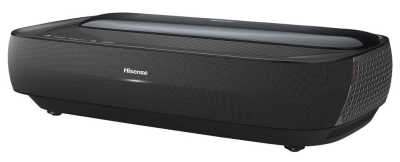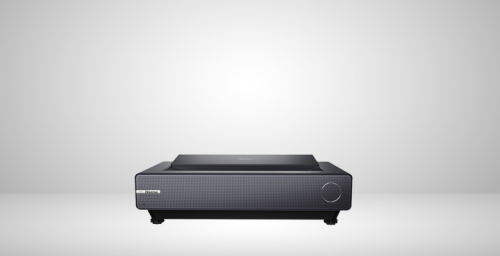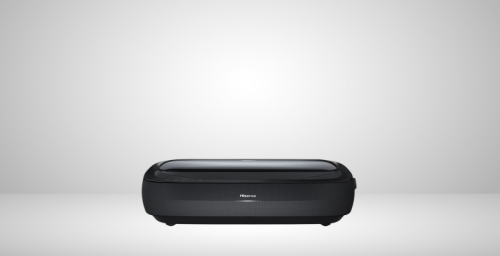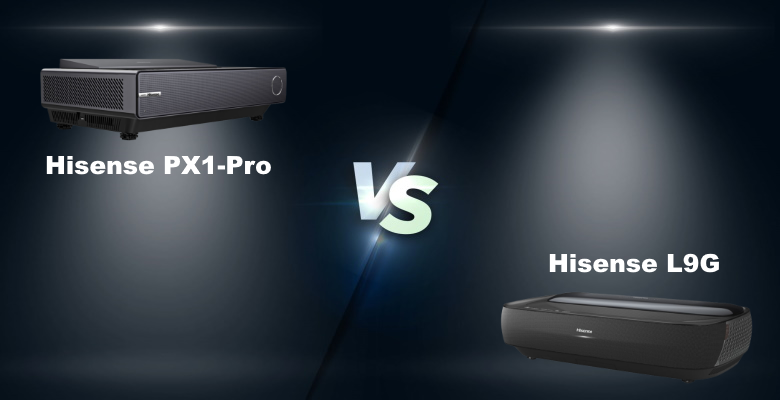When you have a limited amount of space, using a home theater projector isn’t always easy. Issues with image size and alignment are common. However, Hisense has a line of ultra-short throw projectors that only require 80 inches or less of space for 100-inch onscreen images.
The PX1-Pro and the L9G by Hisense are both ultra-short throw projectors. They also produce stunning images, come with a high lumens rating, and are a breeze to set up. However, there are differences between the two projectors. For example, the L9G is better equipped at handling ambient lighting (>>> Check on Amazon), while the PX1-Pro offers something for movie buffs and gamers.
Here’s a closer look at the similarities and differences between the Hisense PX1-Pro vs the L9G.
Hisense PX1-Pro vs L9G Specifications:
| Hisense PX1-Pro | Hisense L9G | |
|---|---|---|
 |  |
|
| Resolution | 3840x2160 | 3840x2160 |
| Contrast Ratio | 1,000,000:1 | 1,000,000:1 |
| Brightness (Lumens) | 2,200 ANSI | 3,000 ANSI |
| Input lag | 30ms | 34ms |
| Throw Distance | 1.6' - 2.4' | 1.8' - 2.2' |
| Screen size | 90" - 130" | 100" - 120" |
| Internal Speakers | 15.0 Watts × 2 | 20.0 Watts × 2 |
| Price | Find on Amazon ProjectorScreen.com Bhphotovideo.com | Find on Amazon ProjectorScreen.com Bhphotovideo.com |
Image Quality
Both models use a TriChroma laser to produce accurate colors. You get up to 107% of the BT.2020 spectrum, thanks to the combination of green, red, and blue lasers. Since the projectors do not use a color wheel, issues with bleeding or rainbowing are never a problem. You get immersive colors whether you are watching a movie or gaming.
4K resolution is also standard on both projectors, and HDR tone mapping on the L9G further enhances image quality. The L9G may also be a better option in bright spaces. It has a higher lumens rating at 3,000, compared to 2,200 with the PX1-Pro.
Best Image Quality: Hisense L9G
Ease of Installation and Set Up
One of the first things you notice is the size and weight of the L9G. While neither projector is lightweight or compact, the L9G weighs over 80 lbs. It also measures 60 x 25 x 20 inches, so finding an installation spot can be a little difficult. The projector does come with a tabletop mount, so you don’t have to worry about making additional purchases.
In comparison, the PX1-Pro weighs slightly over 20 lbs. and measures 20.5 x 12.8 x 6.3 inches. It’s a little easier to move around, and you have a few more options on where you set up the projector. Both are ultra-short throw models, so you aren’t going to need a lot of space between the lens and screen. With 90 inches or less, with the PX1-Pro, you can cast 100” images.
Easiest to Install: Hisense PX1-Pro
Audio Quality
Home theater projectors aren’t typically known for their audio quality. However, both the PX1-Pro and L9G come with onboard speakers. The speakers are a noticeable upgrade from the ones in most smart TVs. Some consumers even skip adding external speakers to the setup.
The PX1-Pro boasts 30W speakers and Dolby Atmos sound processing technology. You can use the projector as an audio and video center. However, audiophiles may want to look at the L9G. It produces audio similar to a basic soundbar with its four forward-firing 40W speakers. Both projectors also come with integrated eARC, making it easy to connect them to your existing sound system.
Best Audio Quality: Hisense L9G
Connectivity
A home theater projector is almost useless if you can’t connect to streaming services and external devices. The L9G offers the most connectivity. While the PX1-Pro only offers two HDMI ports, the L9G comes with three. You still have two HDMI ports if you take advantage of eARC connectivity.
Dual USB ports are standard on the projectors, along with optical and digital outputs. Built-in Alexa and Google Assistant make it easy to find and stream the latest content.
Best Connectivity: Hisense L9G
Hisense PX1-Pro

Compared to other ultra-short throw projects, the PX1-Pro is relatively compact, making it a little easier to install. Aligning onscreen images does involve adjusting the projector since the lens is fixed at a 0.25:1 throw ratio. It does come with calibration controls, so you can fine-tune the images. Thanks to the motorized focusing, you can easily adjust the picture to fit 90 to 130-inch screens.
The 2,200 lumens rating is a little low, but it can handle most ambient light, thanks to other included technologies. The triple laser, 4K resolution, motion handling, and high, dynamic contrast ratio help ensure onscreen images are crisp and bright.
When it comes to audio quality, you can skip the eternal speakers. The projector has an integrated sound system with six modes. Choose from sports, theater, music, speech, late night, or standard depending on your preferences. Dolby Atmos processing ensures audio is crisp and clear. Click here for our more detailed review of the Hisense PX1-Pro.
Pros
- Easy installation
- Bright, crisp images
- Ultra-short throw distance
- Onboard speakers with six modes
- Incredibly accurate and vibrant colors
Cons
- The projector does not support 3D content or Netflix
- It has limited connectivity with only two HDMI ports
Hisense L9G

The L9G is an ultra-short throw projector but get ready for its size and weight. It’s not compact or easy to move around. However, the included table mount helps with the installation. You also have the option of adding on a 100 or 120-inch screen. The screen comes with an adjustable hanger, making it easier to adjust and align images since the lens is fixed on the projector.
Even though the L9G is not the only projector to boast onboard speakers. Its integrated sound system is a step above most competitors. It comes with four 40W forward-firing speakers supported by Dolby Atmos. It also comes with eARC support and is ready for use with a WiSA transmitter. Add in the robust control panel that includes ports for external speakers, and you are ready to enjoy music and movies.
Gamers aren’t left out. The L9G comes with a dedicated gaming mode, unlike some other ultra-short throw projectors. Latency speeds are around 34ms in 4K. It’s not great, but it works for casual gaming. Turning on the gaming mode does lower the dynamic contrast and resolution, but you get an input lag that can keep up with your action-packed games. To improve image quality in gaming mode, simply adjust the color temperature.
Pros
- Accurate, bright colors
- Robust control panel
- Low input lag in gaming mode
- HDR support
- Four forward-firing onboard speakers
Cons
- Its weight can make installation a little difficult
- The projector does not support Netflix or 3D content without an external device
Conclusion
Comparing the Hisense PX1-Pro vs the L9G highlights the projectors’ similarities and differences. Neither model supports Netflix or 3D content, you will need to use a streaming stick or external device to access the content.
The PX1-Pro has a lower price point and is significantly lighter in weight. Its compact size also makes it easier to install. However, the L9G boasts a stronger onboard sound system and a more robust control panel. You also have the option of adding a projector screen onto your order (>>> Find on ProjectorScreen).
